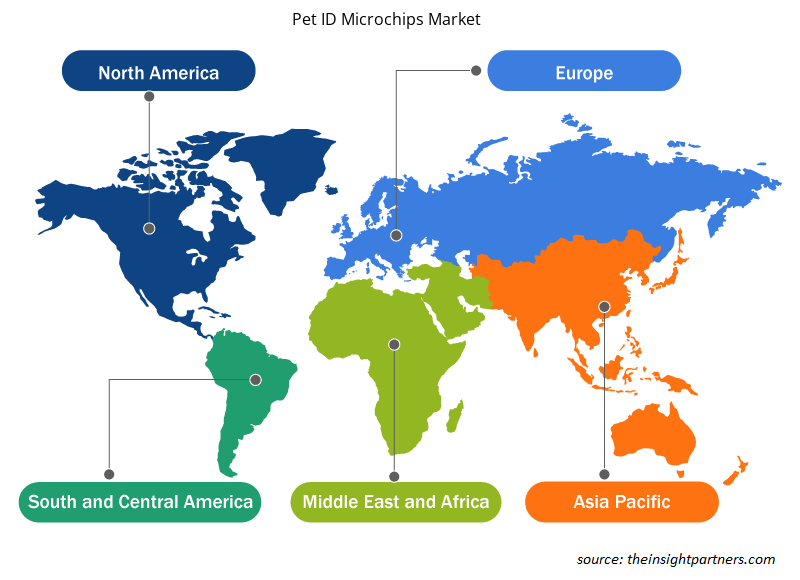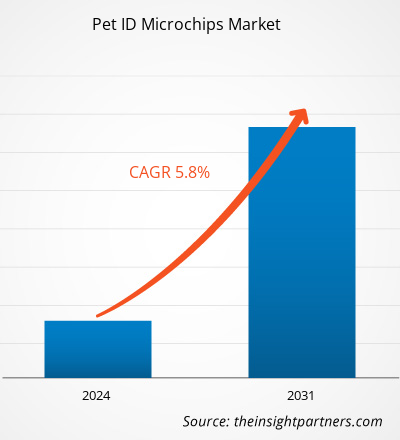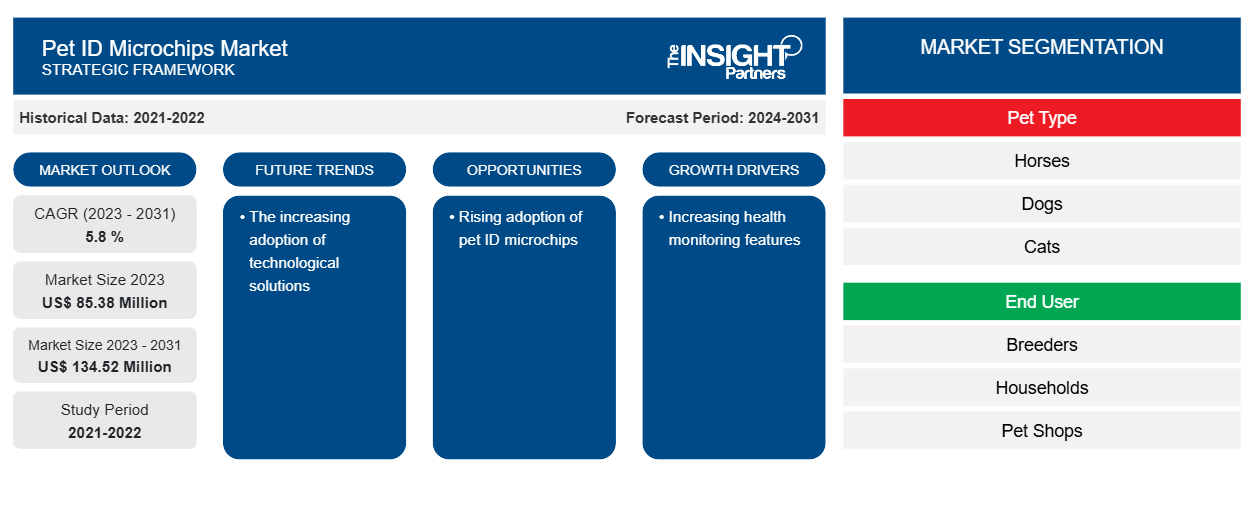Si prevede che il mercato dei microchip per l'identificazione degli animali domestici raggiungerà i 134,52 milioni di dollari USA entro il 2031, rispetto agli 85,38 milioni di dollari USA del 2023. Si prevede che il mercato registrerà un CAGR del 5,8% nel periodo 2023-2031. È probabile che la crescente adozione di soluzioni tecnologiche rimanga una tendenza chiave nel mercato.
Analisi di mercato dei microchip per l'identificazione degli animali domestici
Un singolo chip rimarrà funzionale fino a 25 anni e durerà per tutta la vita dell'animale. La maggior parte dei chip odierni funziona a 134,2 kHz, mentre alcuni microchip da 125 kHz sono ancora disponibili negli Stati Uniti. Inoltre, il microchip ha ridotto significativamente le sue dimensioni e migliorato la lettura della temperatura dell'animale quando viene scansionato con uno scanner per microchip. I microchip sono un metodo efficace per identificare gli animali domestici poiché sono incorporati all'interno del corpo e, pertanto, non possono essere masticati, rimossi, strappati o falsificati. I veterinari e le associazioni di beneficenza per il benessere degli animali in tutto il mondo stanno adottando i mandati di microchip di identificazione degli animali domestici imposti dalle normative.
Panoramica del mercato dei microchip per l'identificazione degli animali domestici
Un microchip è un piccolo dispositivo elettronico che contiene tutte le informazioni pertinenti. In questo chip, c'è un numero che può identificare con precisione l'animale domestico. Per ottenere un chip, i proprietari devono visitare un veterinario che lo inietterà leggermente sotto la pelle del loro animale domestico. La procedura è dolorosa, quindi non richiede l'uso di anestesia. All'interno del microchip, c'è un numero di registrazione del suo registro. Quando sorge la necessità, uno scanner può recuperare le informazioni di registro sull'animale domestico. I microchip sono ideali per l'identificazione permanente e a prova di manomissione, ma non sostituiscono un collare con etichette di identificazione aggiornate.
Personalizza questo report in base alle tue esigenze
Riceverai la personalizzazione gratuita di qualsiasi report, comprese parti di questo report, o analisi a livello nazionale, pacchetto dati Excel, oltre a usufruire di grandi offerte e sconti per start-up e università
-
Scopri le principali tendenze di mercato in questo rapporto.Questo campione GRATUITO includerà analisi di dati che spaziano dalle tendenze di mercato alle stime e alle previsioni.
Driver e opportunità del mercato dei microchip per l'identificazione degli animali domestici
Crescente adozione di microchip identificativi per animali domestici
Vari specialisti di identificazione di animali domestici offrono microchip di identificazione di animali domestici ai clienti di tutti i settori del benessere degli animali, tra cui soccorso, veterinario, toelettatura, autorità locali, allevatori, servizi per animali domestici e zoo. Inoltre, i fornitori di Pet-ID offrono progetti di conservazione della fauna selvatica in varie regioni, come il Regno Unito e altre. Ad esempio, nell'ottobre 2022, MSD Animal Health ha lanciato HomeAgain Thermochip, un nuovo microchip di identificazione che incorpora un biosensore di temperatura che misura la temperatura sottocutanea del gatto o del cane. Pertanto, la crescente adozione di microchip di identificazione di animali domestici sta guidando il mercato dei microchip di identificazione di animali domestici.
Aumento delle funzionalità di monitoraggio della salute
Gli accessori indossabili sono elementi essenziali dei sistemi di monitoraggio della salute intelligenti per animali domestici. Raccolgono varie informazioni sulla salute tramite sensori incorporati in collari o imbracature, fornendo informazioni preziose per la salute del tuo animale domestico. Dispositivi come FitBark o Whistle si attaccano al collare dell'animale domestico e monitorano i livelli di attività fisica, i modelli di sonno e il consumo di calorie. Forniscono informazioni sulla forma fisica e sui livelli di energia dell'animale domestico. I marchi Tractive e Link AKC offrono collari con GPS, che consentono di tracciare la posizione del tuo animale domestico in qualsiasi momento. Ciò è particolarmente utile per gli animali domestici che vivono all'aperto o che sono inclini a vagare. Pertanto, le crescenti funzionalità di monitoraggio della salute stanno creando maggiori opportunità per il mercato.
Analisi della segmentazione del rapporto di mercato sui microchip per l'identificazione degli animali domestici
I segmenti chiave che hanno contribuito alla derivazione dell'analisi di mercato dei microchip identificativi per animali domestici sono la tipologia di animale domestico e l'utente finale.
- In base al componente , il mercato dei microchip per l'identificazione degli animali domestici è suddiviso in cavalli, cani, gatti e altri. Il segmento dei cavalli ha detenuto una quota di mercato maggiore nel 2023.
- In base all'utente finale, il mercato è segmentato in allevatori, famiglie, negozi di animali e altri.
Analisi della quota di mercato dei microchip per l'identificazione degli animali domestici per area geografica
L'ambito geografico del rapporto sul mercato dei microchip identificativi per animali domestici è suddiviso principalmente in cinque regioni: Nord America, Asia Pacifico, Europa, Medio Oriente e Africa, e Sud e Centro America.
Il Nord America domina il mercato dei microchip identificativi per animali domestici. Secondo l'American Pet Products Association (APPA), le persone negli Stati Uniti spenderanno circa 109,6 miliardi di dollari per i loro animali domestici nel 2022. Inoltre, gli accessori per animali domestici stanno diventando più avanzati e c'è un numero crescente di invenzioni e sviluppi nel settore degli animali domestici. Pertanto, la domanda di microchip per animali domestici sta aumentando nella regione.
Approfondimenti regionali sul mercato dei microchip per l'identificazione degli animali domestici
Le tendenze regionali e i fattori che influenzano il mercato dei microchip per l'identificazione degli animali domestici durante il periodo di previsione sono stati ampiamente spiegati dagli analisti di Insight Partners. Questa sezione discute anche i segmenti e la geografia del mercato dei microchip per l'identificazione degli animali domestici in Nord America, Europa, Asia Pacifico, Medio Oriente e Africa e America meridionale e centrale.

- Ottieni i dati specifici regionali per il mercato dei microchip per l'identificazione degli animali domestici
Ambito del rapporto di mercato sui microchip per l'identificazione degli animali domestici
| Attributo del report | Dettagli |
|---|---|
| Dimensioni del mercato nel 2023 | 85,38 milioni di dollari USA |
| Dimensioni del mercato entro il 2031 | 134,52 milioni di dollari USA |
| CAGR globale (2023-2031) | 5,8% |
| Dati storici | 2021-2022 |
| Periodo di previsione | 2024-2031 |
| Segmenti coperti |
Per tipo di animale domestico
|
| Regioni e Paesi coperti |
America del Nord
|
| Leader di mercato e profili aziendali chiave |
|
Densità dei player del mercato dei microchip per l'identificazione degli animali domestici: comprendere il suo impatto sulle dinamiche aziendali
Il mercato dei microchip per l'identificazione degli animali domestici sta crescendo rapidamente, spinto dalla crescente domanda degli utenti finali dovuta a fattori quali l'evoluzione delle preferenze dei consumatori, i progressi tecnologici e una maggiore consapevolezza dei vantaggi del prodotto. Con l'aumento della domanda, le aziende stanno ampliando le loro offerte, innovando per soddisfare le esigenze dei consumatori e capitalizzando sulle tendenze emergenti, il che alimenta ulteriormente la crescita del mercato.
La densità degli operatori di mercato si riferisce alla distribuzione di aziende o società che operano in un particolare mercato o settore. Indica quanti concorrenti (operatori di mercato) sono presenti in un dato spazio di mercato in relazione alle sue dimensioni o al valore di mercato totale.
Le principali aziende che operano nel mercato dei microchip per l'identificazione degli animali domestici sono:
- Salute degli animali domestici Inc.
- Merck & Co. Inc
- Elanco Salute Animale Inc
- Sistemi di identificazione Avid Inc
- Datamars SA
- Trovan Ltd
Disclaimer : le aziende elencate sopra non sono classificate secondo un ordine particolare.

- Ottieni una panoramica dei principali attori del mercato dei microchip per l'identificazione degli animali domestici
Notizie di mercato e sviluppi recenti sui microchip per l'identificazione degli animali domestici
Il mercato dei microchip per l'identificazione degli animali domestici viene valutato raccogliendo dati qualitativi e quantitativi dopo la ricerca primaria e secondaria, che include importanti pubblicazioni aziendali, dati di associazioni e database. Di seguito sono elencati alcuni degli sviluppi nel mercato dei microchip per l'identificazione degli animali domestici:
- PetPace ™, leader nel monitoraggio avanzato della salute degli animali domestici, ha annunciato il lancio di PetPace 2.0, un collare intelligente per cani salvavita basato sull'intelligenza artificiale che fornisce informazioni mediche continue e quasi in tempo reale per la diagnosi precoce, il trattamento, il monitoraggio e il tracciamento GPS della salute canina. PetPace migliora la salute e la qualità della vita degli animali domestici tramite il monitoraggio remoto per portare tranquillità ai proprietari di animali domestici. (Fonte: PetPace, comunicato stampa, maggio 2024.)
- International Alliance Technologies propone di lanciare il suo prodotto di punta, un tag identificativo per animali domestici con codice QR, il 26 aprile. Il tag è collegato a un database di informazioni che è gratuito da utilizzare dopo l'attivazione. Il database include informazioni personali protette, come indirizzo e numero di telefono del proprietario, cartelle cliniche, informazioni di contatto del veterinario e altro ancora, garantendo inoltre l'accesso al servizio clienti 24 ore su 24, 7 giorni su 7. (Fonte: International Alliance Technologies, comunicato stampa, aprile 2021)
Copertura e risultati del rapporto di mercato sui microchip per l'identificazione degli animali domestici
Il rapporto "Dimensioni e previsioni del mercato dei microchip per l'identificazione degli animali domestici (2021-2031)" fornisce un'analisi dettagliata del mercato che copre le seguenti aree:
- Dimensioni e previsioni del mercato dei microchip per l'identificazione degli animali domestici a livello globale, regionale e nazionale per tutti i principali segmenti di mercato coperti dall'ambito
- Tendenze del mercato dei microchip per l'identificazione degli animali domestici e dinamiche di mercato come conducenti, sistemi di ritenuta e opportunità chiave
- Analisi dettagliata delle cinque forze PEST/Porter e SWOT
- analisi di mercato dei microchip per l'identificazione degli animali domestici che copre le principali tendenze del mercato, il quadro globale e regionale, i principali attori, le normative e i recenti sviluppi del mercato
- Analisi del panorama industriale e della concorrenza che copre la concentrazione del mercato, l'analisi della mappa di calore, i principali attori e gli sviluppi recenti per il mercato dei microchip di identificazione degli animali domestici
- Profili aziendali dettagliati
- Analisi storica (2 anni), anno base, previsione (7 anni) con CAGR
- Analisi PEST e SWOT
- Valore/volume delle dimensioni del mercato - Globale, Regionale, Nazionale
- Industria e panorama competitivo
- Set di dati Excel
Report recenti
Rapporti correlati
Testimonianze
Motivo dell'acquisto
- Processo decisionale informato
- Comprensione delle dinamiche di mercato
- Analisi competitiva
- Analisi dei clienti
- Previsioni di mercato
- Mitigazione del rischio
- Pianificazione strategica
- Giustificazione degli investimenti
- Identificazione dei mercati emergenti
- Miglioramento delle strategie di marketing
- Aumento dell'efficienza operativa
- Allineamento alle tendenze normative























 Ottieni un campione gratuito per - Mercato dei microchip identificativi per animali domestici
Ottieni un campione gratuito per - Mercato dei microchip identificativi per animali domestici